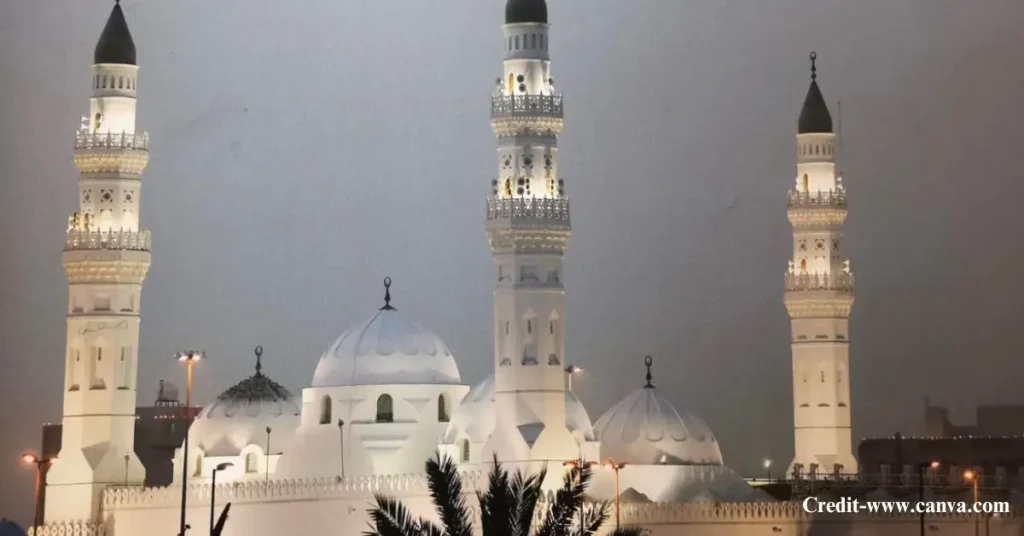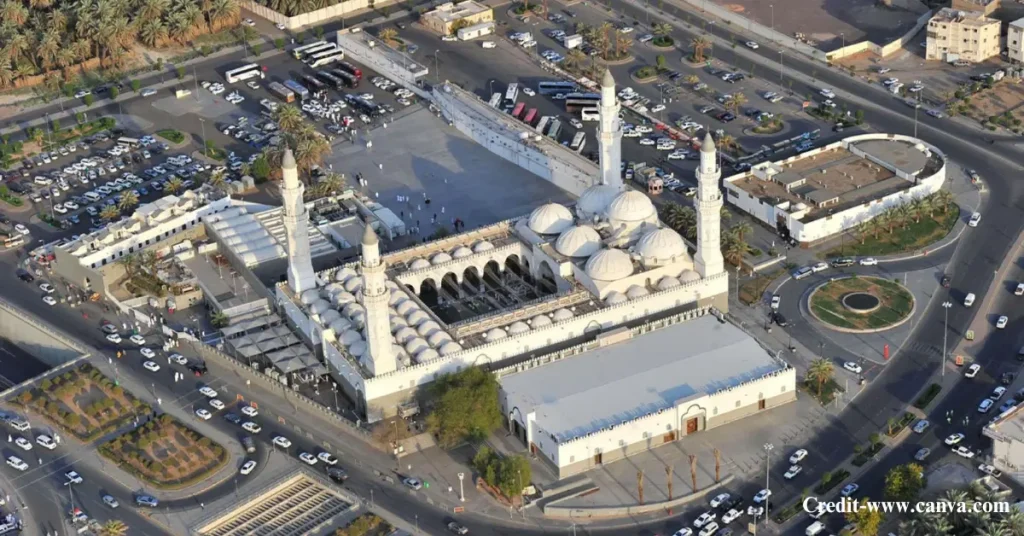She turned off her phone. She took a breath and entered the white marbled courtyard of Masjid e Quba. For a moment, all around her looked still – she saw no messages and heard no noise, only peace. Many people talk about this feeling when they visit Masjid Quba in Madinah. But what gives this mosque its special character?
It is more than a stop on a religious tour. Masjid e Quba became the first mosque in Islam. The Prophet Muhammad (peace be upon him) built it himself. He constructed the building after the Hijrah, a journey from Makkah to Madinah. This is where a new Muslim society began. Workers put it up not only with mud and bricks but with unity, faith, and new hope.
Could we please look at its story? We will see how it began, why it matters, and what it means to people today.
Table of Contents

The Beginning: Prophet Muhammad’s Arrival in Quba
The Prophet (PBUH) journeyed from Makkah to Madinah. He did not travel straight to the city. He stayed in Quba, a small village that sat just outside Madinah. In that quiet spot, he put up the first mosque in Islam, Masjid e Quba.
The Prophet did not build it alone. His companions helped him lay each brick. They used mud bricks and palm trunks, keeping it simple and humble. But the purpose was deep—it was more than just a place to pray. It was the start of a fresh chapter, where the Muslim community could grow without fear or pressure.
Masjid Quba in the Quran
The Quran speaks of the mosque. The book states, “And a mosque, founded on piety from the first day, has more worth as a place to stand” (Surah At-Tawbah (9:108)). All scholars hold that the verse refers to Masjid Quba.
A verse from the Quran puts the mosque in a distinct place in Islamic history. It’s not just known for being the first—it’s known for being built with pure intentions and deep belief.
The Reward of Praying at Masjid Quba
A Hadith shows that people who go to Madinah ought to visit this mosque. The Prophet (PBUH) said that praying two rak’ahs at Masjid Quba brings the same reward as finishing a small Umrah. This advantage causes many Muslims to stop there when they do the Umrah or the Hajj.
Each Saturday, the Prophet walked from Masjid an-Nabawi to Masjid Quba. He prayed at that site. Many pilgrims and local people go along that path. People call this route the Quba Walk.
The Architecture: From Mud Walls to Marble Domes
When it was first built, the mosque was very simple—palm trunks as pillars, a roof of palm fronds, and a prayer direction toward Jerusalem. Over time, the mosque changed:
Caliph Uthman stretched it. Abbasids, Mamluks, and Ottomans put on more touches. In 1986, under King Fahd, builders restored the mosque completely.
Masjid Quba takes in about 20,000 worshippers – it has:
- 56 domes
- 4 tall minarets
- Modern cooling systems
- Separate prayer areas for men and women
- Shaded courtyards to help with the Madinah heat
But even with all these updates, the peaceful soul of the mosque hasn’t changed.
Hidden Stories: The Well of Aris and the Lost Ring
Masjid Quba offers more than its visible features. A story many do not hear concerns the Well of Aris, also named Bir al-Khatim. People say the Prophet’s ring went into this well. Although many searched for it, no one ever found it. That small puzzle still makes people wonder.
Another critical point involves the story of Masjid al-Dirar. Hypocrites built this structure nearby to cause trouble in the Muslim group. The Prophet (PBUH) told people to tear it down. This demonstrates how Masjid Quba represented truth and unity from its start.
The First Friday Sermon (Khutbah)
Not many know this, but the first Friday sermon after Hijrah was given near Quba before the Prophet reached central Madinah. It was simple and full of advice:
- Be united
- Be honest
- Worship sincerely
No stage, no decoration—just a group of believers in the open. That’s how Islam began—with truth, not show.
Why Masjid Quba Still Matters Today
Quba Mosque is a working place, not only an old building – it remains active, shows a lot of life, and holds much meaning. People who live there and those who travel visit it each week. Many walk the 4.4-kilometre path from the Prophet’s Mosque to Quba, as the Prophet did. Other people use a bus or a taxi to travel.
But they visit for the exact cause – they look for calm, a reason, as well as a tie to the past.
The Quba Walk: Walking in the Prophet’s Footsteps
The Quba Walk has become a peaceful path for reflection. The walk measures around 4.4 kilometres. Date stalls, small cafes, and locals offering tea or fruit line the path.
It’s not about the distance. It’s about the thought behind each step. Some pad, thinking about the Prophet’s journey. Others go in groups, talking about faith, family, and the simple power of being present.
Modern Setup and Facilities
Masjid Quba is well-prepared for visitors:
- Wide walkways and shaded areas
- Separate sections for men and women
- Volunteers who help and guide
- Cooling systems that work well in the heat
- Rest areas and smooth access for older people or the disabled
Right outside, Quba Square has shops, food stalls, and shaded spots where people relax after prayer.
What Visitors Say
People who travel often say how they felt when they went to places
- “I went into Masjid Quba and immediately felt quiet. The place is not as large as Masjid an-Nabawi, but it has a private feel – it was calm, holy, and full of its past.”
- “A person walked from Masjid an-Nabawi to Quba. The walk was quiet and spiritual. It helped me consider the Prophet’s difficulties truly.”
These accounts do not come from guides; they come from ordinary people who had a genuine feeling.
Travel Tips for Visitors to Masjid Quba
Know about the transportation means to Masjid Quba when you plan to visit Madinah. The mosque is approximately 4.4 km from Masjid an-Nabawi. The easiest would be by taxi service, but bus services are always available. You can also walk. Many people choose to walk as they follow the Prophet’s path.
Start your trip early in the day when the weather is cool. Bring water. Wear comfortable shoes. Your phone should be light since you will not use it often when you get there.
Women have a prayer area and specific times to use it. The mosque welcomes visitors, plus volunteers offer help if you need guidance.
Community Events and Daily Life at Masjid Quba
Quba Mosque offers more than a tourist stop. People who live near the mosque visit daily to pray. On Fridays and weekends, the building appears more active. Children, along with guests, collect there quietly.
During Ramadan, the mosque shows more beauty. Shared meals as well as prayers add a calm yet powerful energy to the location – it is a place where people assemble for community, kindness, in addition to faith.
Why Kids and Families Love Visiting Masjid Quba
Masjid Quba isn’t only peaceful for adults—it’s an excellent place for children too. The big open courtyards give kids room to move, and parents can still focus on prayer. Many parents say that this mosque leaves a significant mark on their children’s memories.
It helps them feel proud of their roots and gives them real stories to remember.

Final Thoughts
The Quba Mosque stands as the first mosque in Islam – it represents new beginnings, sacrifice, unity, and sincere belief. The mosque began with mud walls and now has smooth white marble. It still welcomes people from all places.
When you are in Madinah, visit this mosque. You can pray there or walk the Quba path. Perhaps you simply sit quietly. You will go away with more than you had before.
This location belongs to the past, but it also belongs to each believer’s trip.

